Nasa's Curiosity Mars rover set for high risk landing
- Published
- comments
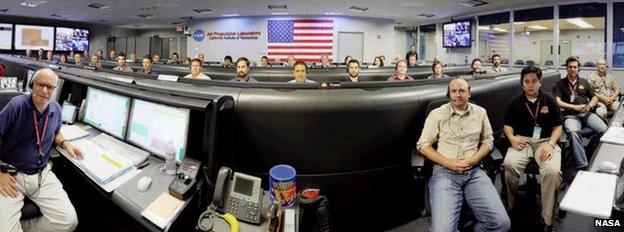
Mission control is ready for the descent. Note the pot of peanuts at front-centre - a landing tradition
One of the most daring space missions ever undertaken is nearing Mars.
Nasa will attempt to land its one-tonne Curiosity rover, external on the Red Planet to study the possibility that this world may once have hosted microbial life.
The vehicle is packed with scientific instruments, including a laser that can zap rocks to determine their make-up.
Curiosity is currently hurtling through space, close to the end of a 570 million km journey from Earth.
Engineers describe its trajectory as near-perfect and they have passed up the last two opportunities to make course corrections.
Doug McCuistion: 'It will be really exciting; it always is'
The rover, tucked inside a protective shell, is due to begin its descent to the surface at 05:24 GMT, Monday (06:24 BST; 22:24 PDT, Sun).
A signal confirming it has landed inside a deep depression known as Gale Crater is expected on Earth about seven minutes later, at 05:31 GMT.
But getting this audacious exploration project safely down will be a colossal challenge.
Two-thirds of all missions sent to the Red Planet have failed, a good many lost on entry into the thin but unforgiving Martian atmosphere.
And yet, the US space agency has high confidence that the high-risk descent strategy its engineers have devised will deliver an intact vehicle to the surface.
This strategy will use a sequence of fully automated manoeuvres to slow the fall from an initial 20,000km/h at the top of the atmosphere to less than 1m/s at the moment of touch-down.
The last stage in the sequence will see a hovering, rocket-powered crane lower the rover to the ground on nylon cords.
The manoeuvres have raised eyebrows because of their complexity, but the entry, descent and landing (EDL) team leader, Adam Steltzner, has emphasised the amount of "reasoned engineering" that has informed the design.
"I slept better last night than I have in years, and I think that's because it's done - whatever's going to happen is going to happen," he said.
Nasa will be monitoring the drama from the Jet Propulsion Laboratory (JPL) in Pasadena, California.
It is here that mission control will receive the telemetry from Curiosity that has been bounced to Earth by the overflying satellite known as Odyssey.
Engineers can only watch and wait, however. The 250 million km between Mars and Earth right now means there is a 13-minute lag in communications.
The mission team knows that when it gets that first signal to say the rover has entered the planet's atmosphere, the vehicle will in reality have already landed or been destroyed some seven minutes previously.
Step by step: How the Curiosity rover will land on Mars
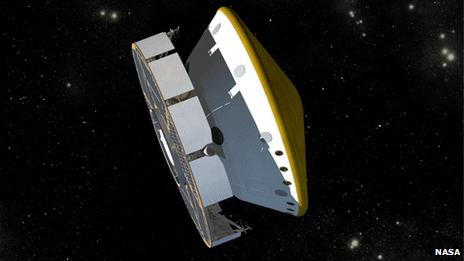
As the rover, tucked inside its protective capsule, heads to Mars, it dumps the disc-shaped cruise stage that has shepherded it from Earth.

The capsule hits the top of the atmosphere at 20,000km/h. It ejects ballast blocks and fires thrusters to control the trajectory of the descent.
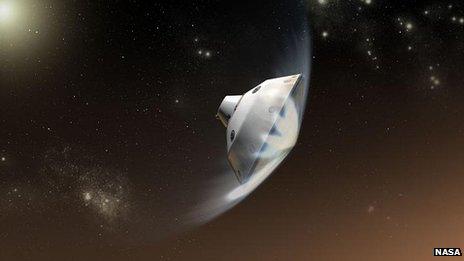
Most of the entry vehicle's energy is dissipated in the plunge through the atmosphere. The front shield heats up to more than 2,000C

The parachute deploys when the capsule is about 11km above the ground but still moving at supersonic speed.
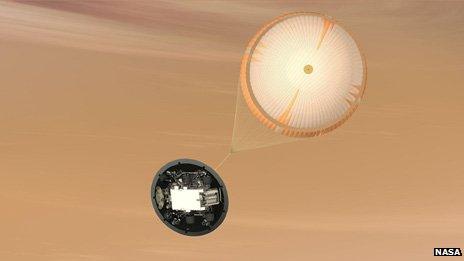
A key event is the dropping of the heat shield. This permits imaging and radar instruments to monitor the approaching surface.
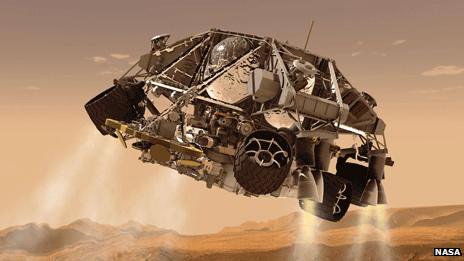
At about 1.5km above the ground and still moving at 80m/s, the rover and its sky crane drop away from the parachute and capsule backshell
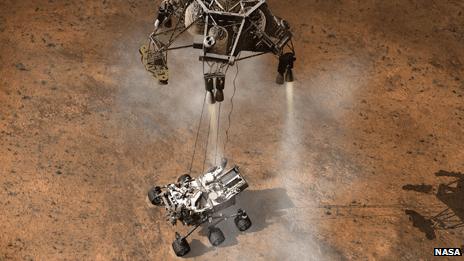
Rockets on the sky crane slow the descent to 1m/s. Cords spool the rover to the surface. The cords are then cut and the crane flies away to a safe distance
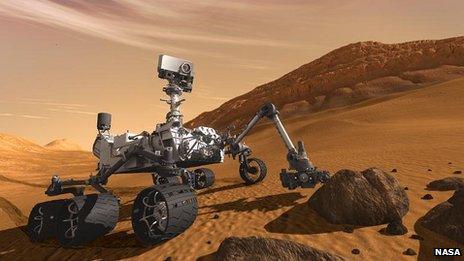
The rover is equipped with a nuclear battery and should have ample power to keep rolling across the Martian surface for many years.
"It will be really exciting; it always is. It's electrifying but it's tense," Doug McCuistion, the director of Nasa's Mars programme, told BBC News.
"Everybody white-knuckles through these 'seven minutes of terror', and it's named that for a good reason."
This is the fourth rover Nasa has attempted to put on the surface of Mars since 1997.
But Curiosity - also known as the Mars Science laboratory (MSL) - dwarfs those previous efforts in size and sophistication.
The rover will sample rocks for signs that Mars was once favourable to life
Assuming the robot lands safely, it will spend 98 (Earth) weeks scouring Martian soils and rocks for any signs that current or past environments on the planet could have supported microbial life.
Gale Crater was chosen as the landing site because satellite pictures had spied sediments in the depression that looked as though they were laid down in the presence of abundant water.
"We see a lot of evidence that water was on Mars in the distant past and flowed across the surface for maybe millions of years," explained Ashwin Vasavada, the MSL-Curiosity deputy project scientist.
"This mission goes one step further by trying to understand whether the environments in which the water persisted were habitable. Were there basic ingredients for life there? We're going to understand what the conditions were like when life was most likely in Mars' ancient history."
The rover is equipped with 10 advanced instruments. It also has a plutonium battery and so should have ample power to keep rolling for more than a decade.
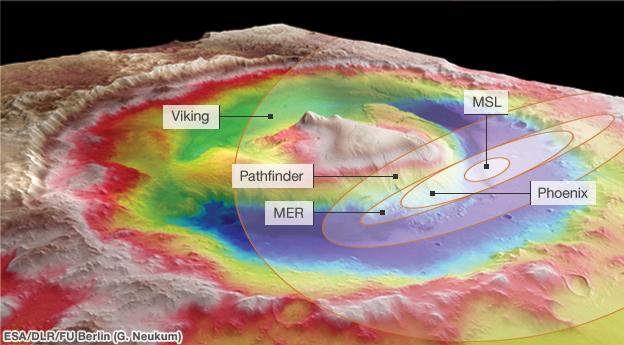
Engineers define an ellipse in which they can confidently land
Successive landings have become ever more accurate
Viking's ellipse was 300km across - wider than Gale Crater itself
Phoenix (100km by 20km) could not confidently fit in Gale
Curiosity's landing system allows it to target the crater floor
The rover's projected landing ellipse is just 7km by 20km
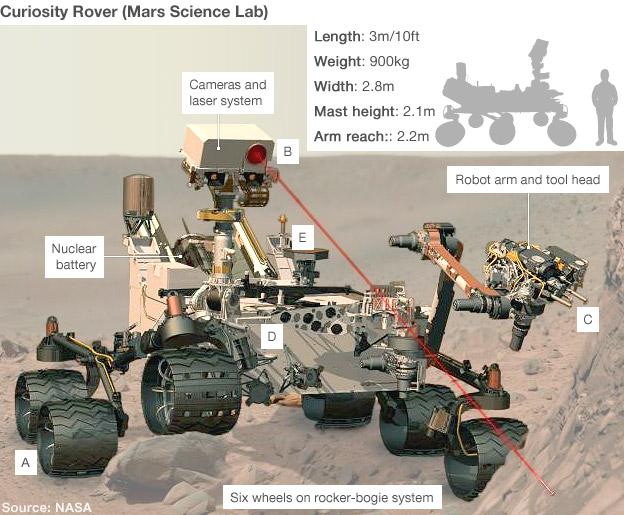
(A) Curiosity will trundle around its landing site looking for interesting rock features to study. Its top speed is about 4cm/s
(B) This mission has 17 cameras. They will identify particular targets, and a laser will zap those rocks to probe their chemistry
(C) If the signal is significant, Curiosity will swing over instruments on its arm for close-up investigation. These include a microscope
(D) Samples drilled from rock, or scooped from the soil, can be delivered to two hi-tech analysis labs inside the rover body
(E) The results are sent to Earth through antennas on the rover deck. Return commands tell the rover where it should drive next
Jonathan.Amos-INTERNET@bbc.co.uk and follow me on Twitter, external
- Published4 August 2012
- Published4 August 2012
- Published30 July 2012
- Published12 June 2012
- Published25 May 2012
- Published26 November 2011
- Published24 November 2011
- Published22 July 2011